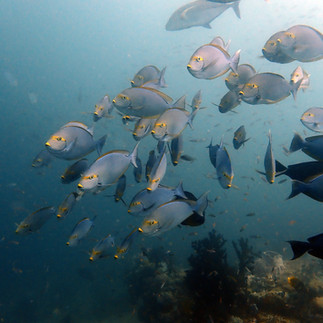5. Triton Bay: Remote … and worth it?!
- Pip Andrews
- Apr 11
- 5 min read
The strap line for the resort is ‘remote … and worth it’. Remote, is definitely right. To get here, you need to fly into one of the main transport hubs for Indonesia (Jakarta or Bali), from there, hop a flight to Sorong (which I did and stopped over and did the Raja Ampat trip), then hop another flight to Kaimana (there isn’t a direct flight so you have to go via Sorong), drive round part of the island then hop a 2 hour speed boat that brings you to Triton Bay Divers. It’s a resort of 9 beach bungalows, a restaurant and dive shop in a tiny bay called Waala Bay, located on Aiduma Island in the Kaimana province of Indonesia.
I’m in bungalow (probably more of a fancy name for a hut) number 6 - the bathroom has part of its ceiling / side open to the jungle behind (by design not disaster!). However, I spent the first 24 hours or so of my stay having a mild panic every time I went into the bathroom and discovered what looked like the world’s biggest, most deformed spider-insect terror-monster making its way down the wall. I’m not sure what passes for ‘wall art’ in these parts is entirely to my taste!
We dive 2-3 times day and eat at set meal times all together in the restaurant. There are 10 of us altogether - 7 Americans, 2 Swiss and me. The owners (Leeza, originally a Brit) and Jack (her Indonesian husband) also always eat with us, tell us about the island and the locals and answers all our dive / locations based questions.
The diving is mostly similar to Raja Ampat with beautiful soft and hard corals, an abundance of fish and a mix of some currents and some peaceful floats. I’ve mainly only added photos of things that are different to those I haven’t seen already. In between the two morning dives, we don’t return to the resort so have our surface interval pulled up onto the closest little beaches where a little tea station is set up by the boat boys and biscuits are handed round. We stop on some of the most pristine and beautiful island beaches to soak in the views. There couldn’t be more idyllic locations for ‘off-gassing’! I’ve indulged in a little bit of shell collecting although quite a lot of them have the annoying habit of sprouting their little crab legs and scuttling, at speed, away from me!
(Photos: schooling tiny fish, anemone shrimp in his anemone, pipe fish, mushroom coral pipe fish - the tiny white ones, juvenile box fish, head shield slug!)
Then to the second part of the strap line ‘…and worth it’. Well, it’s obviously a little slice of actual paradise on a remote strip of beach in amongst the islands … but this is what I really came here for ….’the dive’…. And it did not disappoint. Is it worth it? Yes… YES! We left in the dark at 5.30am and had a 1.5 hour boat trip almost back to Kaimana and around where the huge fishing boats (called bagans) are. The fishermen have taken to throwing their unsailable fish back into the sea and the resident creatures that frequent the channel have taken to swinging by for a snack…. We spent two glorious hours over two dives with some of the seas most majestic of creatures…. A pod of dolphins. And finally, after trips to many destinations where they should have been - I got to see a whale shark. And not just one but 5 - a ‘smaller’ young one - who was only around 5m length and 4 adults - around 8m+ length. They cruised around, ate the fish, feed on the plankton and smaller fish attracted up to the boats and occasionally ‘sucked’ on the fisherman’s fish filled nets, which prompts the fishermen to throw in some fish to try to stop them from their sucking as it breaks the nets!
Whale sharks are the world’s largest sharks - and harmless to humans as they are filter feeders. Indeed, they are by far the biggest fish in the sea (there are larger mammals etc but not fish). They tend to have a squadron of remora following or attached and hitching a ride and they are the absolute majesties of the ocean. 325 dives in and I finally not only saw thembut also got to dive twice with them. I didn’t think anything would touch the manta magic of this trip … and then I spent 2 dives with the whale sharks while a pod of dolphins chatted, called and used location clicks (all of which you can hear under water) as they dived, spun and played around us, eating up all the fish that the whale sharks missed.
In the absolute worst timing ever, my dive camera clicked its last shot at the very beginning of the second dive. As I descended, the bubbles poured out and the water poured into the casing and it flooded. I wasn’t deep so managed to immediately rush it back to the boat, get it all opened and drying and it’s spent some time back at the resort in a box of rice - classic ‘desperation drying out attempt’ but it’s fate was sealed down with the whale sharks and it died. But for a camera, I can’t really imagine a more satisfying ending really. My final two days of diving, I was mostly without camera and forced to use my own eyes to just watch the fish and not take their photos! …. At least I know what my next research and big spend project will be as I look into its replacement - and possibly enquire about what, if anything, insurance might cover but I won’t hold my breath on that! That’ll keep me busy for a while!
********
Quick camera update … some time drying out in rice doesn’t seem to have done anything to help my poor camera … RIP. I did, however, get lent one to use for a couple of dives, which I very my appreciated and was also particularly interested in because it would be the other type of camera I might consider for my next one. It’s made, mostly and specifically, as a waterproof camera and is the preference for a lot of divers. It has its own underwater housing with full capability for all controls. The joy of this one is that it manages underwater photography well and also the camera itself is waterproof to 15m - and you can dive to that depth with it and it continues to work. So, even if you flood it in its housing (which can go to 60m, should you ever need to!), the camera doesn’t die, can all be dried off and used again. I had a little go with the one I borrowed. I need to learn more of the settings etc but I was quite impressed with it. It also switches to ‘auto’ and takes a nice surface interval beach photo too. I will add it to my ‘to consider’ list! Fishy photos are some schooling surgeon fish, anemone (clown) fish and shrimp, a lovely puffer, a stone fish camouflaging with his rocks and a variety of nudis!
And there you have it, a week in Triton Bay almost completed. I’ve up,oared this blog and photos slowly and over the course of a few days overnight as the WiFi chugs along! Today, I am not diving but on the ‘get everything dry’ and off-gas before flying routine, which mostly means I will be reading my book, eating and drinking tea! All that remains for tomorrow (Saturday) is a boat, a plane, a night in Sorong near the airport, then on Sunday, another plane then I’ve got 3 nights in Jakarta. No more diving there, just even more resting, drinking cups of tea and reading my book! How terribly strenuous. I definitely deserve a rest! I may venture out to do a bit of exploring of the capital but I’m lead to believe it’s a little ‘scuzzy’ so I may not even bother!














































































I'm muddled up with timings as it seems weeks ago that you said your camera had died, but I'm sure this is the last of your blogs..... anyway - really pleased its all gone so well. XX